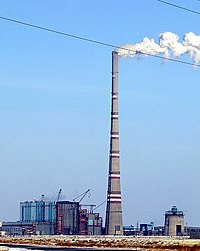
Photo from wikipedia
The properties of activated coke (AC) for sintering flue gas purification greatly affect the efficiency of desulfurization and denitration, but they gradually change during cycles. The change in properties of… Click to show full abstract
The properties of activated coke (AC) for sintering flue gas purification greatly affect the efficiency of desulfurization and denitration, but they gradually change during cycles. The change in properties of coal-based AC during cycles was studied to clarify the change law and AC optimization index. The AC oxygen content rapidly increases from 13.49 to 17.87 wt.% in the early cycles to form phenol, which promotes the denitration rate from 55.63% to 78.20%. The denitration performance slowly increases in subsequent cycles because of the generation of quinone from AC slow oxidation. However, the oxygen-containing groups are not conducive to adsorption capacity of AC for NO. The adsorbed NO species which can be replaced by SO2 is the main NO species on AC, and its amount decreases with the decrease in C=C content of AC. The AC chemical loss leads to the opening of closed pores, expansion of original pores and formation of new pores, causing micropore volume to increase from 0.085% to 0.152%, compressive strength to decrease from 472 to 336 N, and abrasive resistance to decrease from 97.87% to 94.16% during cycles. The low oxygen content and high micropore volume are favorable to the initial desulfurization performance, and the former is more decisive. After a while, the desulfurization rate is linearly positively correlated with the micropore volume regardless of the chemistry. 4-h desulfurization rate increased from 69.03% to 85.91% during 25 cycles due to the increasing micropore volume. The AC properties change in cycles will greatly affect the desulfurization and denitration rate in the height direction of the flue gas purification system. Selecting the coal-based AC with moderate micropore volume, easy oxidation surface and less original oxygen-containing groups facilitates the better purification efficiency at lower cost for sintering plants.
Journal Title: Journal of Iron and Steel Research International
Year Published: 2020
Link to full text (if available)
Share on Social Media: Sign Up to like & get
recommendations!